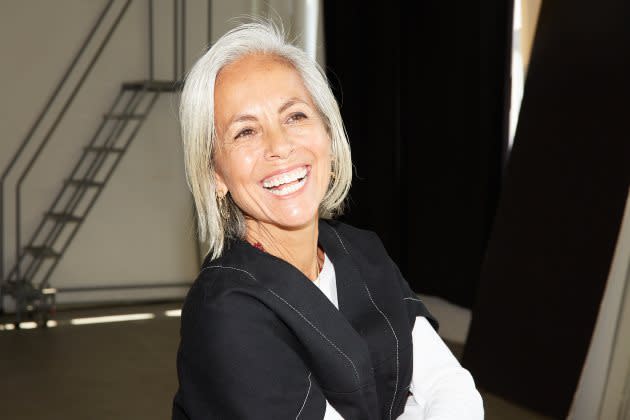Sarabande Foundation Helps Students Answer ‘What Now?’

Generations of fashion-striving students are often left with one question as graduation nears — “What now?”
The Sarabande Foundation, which was started by the late Lee Alexander McQueen, helped a few hundred industry hopefuls answer that question Tuesday at The Standard East Village in New York. Presenting its “What Now?” graduate mentorship program in the U.S. was a first for the organization, which has been offering artists and designers mentoring opportunities, scholarships and subsidized studio space for the past 10 years.
More from WWD
Trino Verkade, who helped McQueen establish Sarabande, said that 800 people had signed up and about 250 turned up. More than 1,000 interviews took place with 22 brands quizzing and advising students. Loewe, Thom Browne, Marc Jacobs, Celine, Khaite, Louis Vuitton, Art + Commerce, Tiffany & Co., Dior and the designer Maria Cornejo personally showed up. Thom Browne’s team was easily identifiable with them coordinating in gray and white-striped attire from his collection. Camaraderie was high with teams from one brand gamely guiding candidates to other companies, when they felt that the candidates would be better suited for others.
Others connected some with fellow fashion friends that they might work well with via LinkedIn.
Recalling how McQueen’s career developed during a recession, Verkade said, “We’re just about hitting another moment of that again. That’s a time when people have less to lose because they don’t have that much around them. So they take risks. It’s also very exciting. A city like Detroit [which has a thriving maker, artist and start-up community] can afford to take risks because they don’t feel as though they have much to lose.
“We don’t need more of the same things. We don’t need people to think commercially with an I-know-this-is-going-to-sell-because-it-sold-before mindset,” she said.
Many of the students were honest about not knowing what they wanted to do, according to a few of the mentors. Ninety in total pitched in. All in all, the brands were impressed with the great portfolios that they saw, Verkade said. And the students were excited to share what they had made and were reassured by the encouragement that they had received from people “who don’t have skin in the game,” Verkade said.
Many were wide-eyed to learn about the range of career opportunities there are beyond design, including AI-related work and sustainability.
The newcomers to the industry, who offered career guidance, are relatable because they know the challenges. The human resources executives could highlight the wide range of jobs that are newer career paths including AI-related work, sustainability and digital fashion. Many companies sent representatives from new divisions in their companies. “A large part of this event was to really point out that things keep changing so quickly. There are new jobs that did not exist five years ago,” Verkade said. “Colleges are not equipped to be on top of these roles and to help people navigate what the industry is looking like now. That’s why it’s really important to get the brands here to say, ‘I need people who can do this right now,’ Verkade said. “It’s not as though they need everybody to be pattern cutters, but they may need somebody [to become] a pattern maker,” she added.
Brands are also not just interested in college degrees but they want to learn about candidates’ hard and soft skills, such as how they think and what their interests are, Verkade said. Candidates in technical design were particularly welcome.
Some students were directed to other opportunities, including one designer whose presentation was so well-packaged that they were advised to consider a career in marketing, Verkade said.
Tuesday’s free one-on-one event was a precursor to Wednesday night’s annual fundraising “Woven” dinner, where guests like Schiaparelli creative director Daniel Roseberry were expected in The Penthouse of The Standard, East Village. The event was being led by Aimee Mullins and Rupert Friend.
Louis Vuitton talent acquisition specialist Kevin Varela said he welcomed every participant and walked them through the universe of Louis Vuitton, all of the opportunities there, general career advice and roles they might want to pursue. A lot of students were interested in design, and some wanted to learn more about corporate posts in marketing, merchandising, communications and digital too, he said. Through “genuine conversations,” Varela said he spoke with attendees about ways to prepare for their future and how they can elevate their résumés, skill sets and portfolios.
There were also up-and-coming industry talent offering advice to the students. Lauren Zampaglione, assistant technical designer for handbags at Marc Jacobs, said as the day wore on, she became more direct in her advice, offering such tips as “Just take this out,” or “put this all on one page.” Having advised 50-plus people, Zampaglione joined Marc Jacobs in January after a few years of a long-term temp post at Kate Spade. Her main advice was: don’t water down your work and style. There’s a lot of pressure to be more commercialized and to try to cater your portfolio and your projects in college, to be more commercial. “For a long time, I was grappling with that. I felt like I had to water myself down because I needed to have a portfolio that is palatable to corporate brands,” Zampaglione said.
Several attendees Tuesday had conceptual work to share, but were concerned about who might want to hire them with that. Zampaglione assured them that such work stands out and “people want to know how you think and the conceptual aspect is so unique to you. You can’t duplicate that. When you interview with a brand, they want to know how you stand out,” she said.
Best of WWD
Solve the daily Crossword

